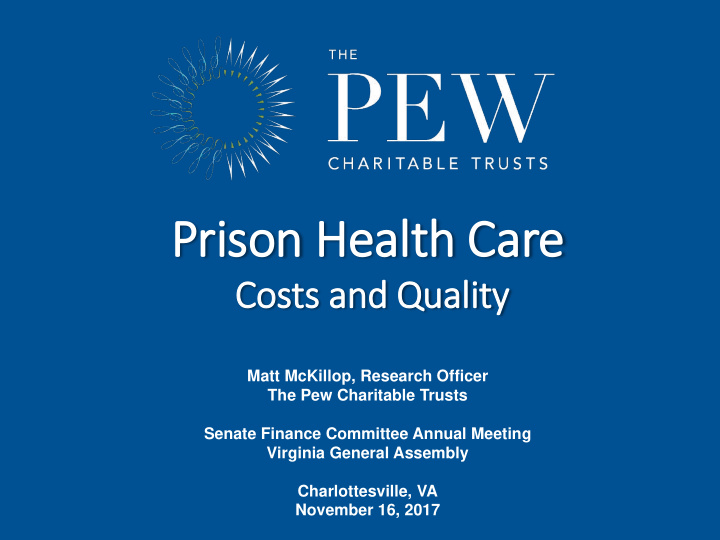



Prison Health Care Costs and Quality Matt McKillop, Research Officer The Pew Charitable Trusts Senate Finance Committee Annual Meeting Virginia General Assembly Charlottesville, VA November 16, 2017 pewtrusts.org/correctionalhealth
Correctional health care research Obje jectives: : • Provide 50-state perspective of how health care is funded and delivered, as well as how care continuity is facilitated. • Help decision-makers assess, improve, and preserve the value of public spending, considering costs and quality. • Highlight policies and practices that achieve universal goals: – meeting constitutional obligations; – strengthening public health; – protecting public safety; – practicing fiscal prudence. Slide 2 pewtrusts.org/correctionalhealth
Key Issues • High stakes of prison health care. • Delivery system models. • Dramatic per-inmate spending variation. Why? How money is spent. o On whom it is spent. o Prices paid. o Accounting for quality. o • Preserving care continuity. Slide 3 pewtrusts.org/correctionalhealth
Slide 4 pewtrusts.org/correctionalhealth
Pressing and universal state priorities Meeting Strengthening public constitutional health obligations Prison Health Care Practicing fiscal Protecting public prudence safety Slide 5 pewtrusts.org/correctionalhealth
Per-in inmate spending on pris ison health care varie ied greatly ly FY 2015 California $19,796 Vermont $13,747 $5,937 Virginia $5,720 49-state median Alabama $3,234 Louisiana $2,173 Slide 6 pewtrusts.org/correctionalhealth
Delivery systems, fiscal 2015 Slide 7 pewtrusts.org/correctionalhealth
Off-site care: financial risk vs. decision to send • Who bears financial risk? – VADOC, with processing by Anthem Blue Cross Blue Shield • Who is responsible for deciding to send an individual offsite for acute treatment? – Armor or Mediko • Partnership with state Medicaid agency? – Eligible individuals are enrolled Slide 8 pewtrusts.org/correctionalhealth
How states spend prison health care dollars Slide 9 pewtrusts.org/correctionalhealth
How VADOC spends prison health care dollars Expenditure FY 2010 FY 2011 FY 2012 FY 2013 FY 2014 FY 2015 FY 2010-15 (nominal) % Change Personal Svcs $27,774,117 $29,811,229 $30,191,201 $28,810,008 $26,231,301 $27,858,122 0.3% Contractual Svcs $102,135,820 $103,719,565 $109,977,654 $114,525,509 $110,755,396 $127,002,857 24.3% Supplies & Mat $16,268,136 $15,896,920 $14,719,653 $14,857,907 $13,439,979 $15,269,951 -6.1 Transfer payments $23,749 $36,598 $9,409 $19,179 $10,610 $10,633 -55.2% Continuous Chgs $124,494 $112,154 $113,557 $104,438 $100,755 $89,814 -27.9% Equipment $95,675 $273,121 $167,466 $140,947 $406,044 $278,535 191.1% Total $146,421,991 $149,849,587 $155,178,940 $158,457,988 $150,944,085 $170,509,912 16.5% • VADOC’s spending disaggregation may hinder a deep examination of cost drivers. Slide 10 pewtrusts.org/correctionalhealth
Accounting for staffing expenditures • Virginia was one of six states excluded from Pew’s staffing level analysis because VADOC did not provide data on its number of contracted health professional FTEs, reporting that the figures were unavailable. Note: New Mexico Corrections Department officials have indicated to Pew that its submitted staffing and spending figures require correction. Slide 11 pewtrusts.org/correctionalhealth
Whom state prison health care dollars treat • VADOC reported tracking the prevalence of two of 15 serious conditions common in incarcerated populations: HIV/AIDS and active tuberculosis. Slide 12 pewtrusts.org/correctionalhealth
Aging prison population, 1999-2015 300% 157,500 prisoners 55 and older 250% Percentage change from 1999 200% 150% 43,300 prisoners 55 and older 100% 1,256,400 1,315,900 prisoners under 55 50% prisoners under 55 0% 1999 2000 2001 2002 2003 2004 2005 2006 2007 2008 2009 2010 2011 2012 2013 2014 2015 -50% Prisoners under 55 Prisoners 55 and older • Incarcerated adults age 55 or older under VADOC’s jurisdiction increased by 45 percent from fiscal 2010-15, growing from 7 percent of its population to 10 percent. Slide 13 pewtrusts.org/correctionalhealth
Aging state prison populations FY 2015 Age 55+ Age 40-54 Age 18-39 Massachusetts 14.4% 33.1% Nevada 13.1% 31.7% Virginia 10.0% 32.0% Indiana 7.6% 25.5% Connecticut 6.8% 27.1% Slide 14 pewtrusts.org/correctionalhealth
Accounting for quality, FY 2016 Slide 15 pewtrusts.org/correctionalhealth
Electronic health records (EHR) and quality monitoring • Majority of prison facilities use EHR in 24 states. – All interoperable between facilities. – Four (IN, IA, NJ, VT) interoperable with community providers. • Not a precondition for monitoring quality. • Can facilitate care continuity. Slide 16 pewtrusts.org/correctionalhealth
Protecting in investments and progress through care continuity Health Coverage Medication Provider maintenance linkages Care Continuity Records Patient sharing education Slide 17 pewtrusts.org/correctionalhealth
State quali lity monit itorin ing systems Insert Fig 10 For additional questions or information, please contact: Matt McKillop mmckillop@pewtrusts.org @mattmckillop 202-540-6398 pewtrusts.org/correctionalhealth pewtrusts.org/correctionalhealth
Recommend
More recommend